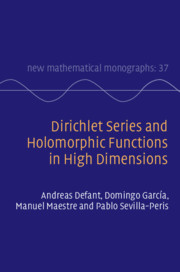Book contents
- Frontmatter
- Contents
- Introduction
- Part 1 Bohr’s Problem and Complex Analysis on Polydiscs
- 1 The Absolute Convergence Problem
- 2 Holomorphic Functions on Polydiscs
- 3 Bohr’s Vision
- 4 Solution to the Problem
- 5 The Fourier Analysis Point of View
- 6 Inequalities I
- 7 Probabilistic Tools I
- 8 Multidimensional Bohr Radii
- 9 Strips under the Microscope
- 10 Monomial Convergence of Holomorphic Functions
- 11 Hardy Spaces of Dirichlet Series
- 12 Bohr’s Problem in Hardy Spaces
- 13 Hardy Spaces and Holomorphy
- Part 2 Advanced Toolbox
- Part 3 Replacing Polydiscs by Other Balls
- Part 4 Vector-Valued Aspects
- References
- Symbol Index
- Subject Index
2 - Holomorphic Functions on Polydiscs
from Part 1 - Bohr’s Problem and Complex Analysis on Polydiscs
Published online by Cambridge University Press: 19 July 2019
- Frontmatter
- Contents
- Introduction
- Part 1 Bohr’s Problem and Complex Analysis on Polydiscs
- 1 The Absolute Convergence Problem
- 2 Holomorphic Functions on Polydiscs
- 3 Bohr’s Vision
- 4 Solution to the Problem
- 5 The Fourier Analysis Point of View
- 6 Inequalities I
- 7 Probabilistic Tools I
- 8 Multidimensional Bohr Radii
- 9 Strips under the Microscope
- 10 Monomial Convergence of Holomorphic Functions
- 11 Hardy Spaces of Dirichlet Series
- 12 Bohr’s Problem in Hardy Spaces
- 13 Hardy Spaces and Holomorphy
- Part 2 Advanced Toolbox
- Part 3 Replacing Polydiscs by Other Balls
- Part 4 Vector-Valued Aspects
- References
- Symbol Index
- Subject Index
Summary
This is a short introduction to the theory of holomorphic functions in finitely and infinitely many variables. We begin with functions in finitely many variables, giving the definition of holomorphic function. Every such function has a monomial series expansion, where the coefficients are given by a Cauchy integral formula. Then we move to infinitely many variables, considering functions defined on B_{c0}, the open unit ball of the space of null sequences. Holomorphic functions are defined by means of Fréchet differentiability. We have versions of Weierstrass and Montel theorems in this setting. Every holomorphic function on B_{c0} defines a family of coefficients through a Cauchy integral formula and a (formal) monomial series expansion. Every bounded analytic (represented by a convergent power series) function is holomorphic. Hilbert’s criterion, that gives conditions on a family of scalars so that it is attached to a bounded holomorphic function on B_{c0}. Homogeneous polynomials are those entire functions having non-zero coefficients only for multi-indices of a given order. We show how these are related to multilinear forms on c0 through the polarization formulas.
Keywords
- Type
- Chapter
- Information
- Publisher: Cambridge University PressPrint publication year: 2019

